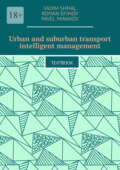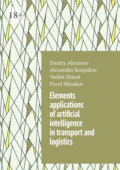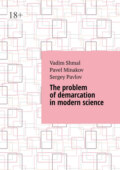
Vadim Shmal
Efficient technologies in railway transport
© Igor Shapkin, 2022
© Pavel Minakov, 2022
© Vadim Shmal, 2022
ISBN 978-5-0059-3948-7
Created with Ridero smart publishing system
INTRODUCTION
The state and prospects of development of the transportation process management system in railway transport in the conditions of reform are considered. The analysis of the world processes of economic development is given, effective ways of transition to landfill technologies for managing the transportation process, modern systems for organizing car traffic and train schedules, systems for operational planning of train and freight work and integration technologies, improving the quality of dispatching control on railways are presented. Modern approaches to the organization and technology of local work in the context of the development of the vertical management system are presented. The advantages of the state approach to the system of train safety in railway transport are shown. The experience of effective management of locomotives in the conditions of the Traction Resource Management Center, as well as the introduction of intelligent transport systems in railway transport and the economic efficiency of technology and transportation management on railways is presented.
Railway transport in Russia occupies a leading place in the development of the country’s economy, providing full, timely and high-quality satisfaction of passenger and freight traffic. Railways link together territories, cities and regions into a single state – Russia.
The reforms carried out in railway transport are aimed at the long-term development of the industry, the introduction of new innovative technologies based on intelligent processes using the latest telecommunication systems, GLONASS, optimization management methods that can significantly improve the quality of transportation, train safety, competitiveness, innovation and efficiency of railway transport.
The most important strategic task is to implement the implementation of the strategy of the Railway Transport Development Program until 2030. The basis of its execution is to improve the quality of operational activities and optimize transportation management. In the development strategy of the Russian Railways Holding, the basic values are: customer orientation, professionalism, innovation and efficiency, implemented through full satisfaction of customer needs based on the provision of quality services that meet international standards.
By implementing the business as an organization of freight transportation, JSC “Russian Railways” ensures the formation of a new line of transport products and an increase in the level of customer service.
An important management tool is the creation of a Central Traffic Management Directorate, whose main tasks are the continuous improvement of transportation management technology, the most productive use of car fleets and locomotives, optimization of infrastructure loading, taking into account the performance of maintenance and repair work. The creation of the structure should be continuously replenished with new technologies of the transportation process, be adequate to the requirements of the market economy at all levels of management.
The solution of the above problems primarily depends on the level of transport science, the effectiveness of which depends on the development of its connection with practice. This is especially important for such a key industry as rail transport. Many scientific ideas, technical developments, complex calculations, technological solutions of transportation management processes, which allows them to be applied more reasonably in the practice of railway operations, to obtain a significant economic effect.
The implementation of the goals in the field of development and implementation of effective technologies and modern methods of solving operational problems in railway transport are set out in this book.
CHAPTER I. IMPLEMENTATION OF THE STRATEGIC DEVELOPMENT PROGRAM OF RAILWAY TRANSPORT FOR THE PERIOD UP TO 2030
1.1 Results of structural reform in railway transport
The Government of the Russian Federation has approved a Program of structural reform in railway transport, which predetermined the large-scale transformations of JSC “Russian Railways”.
The market changes of the nineties determined the need for a radical revision of the model of the entire railway industry, and the deterioration of assets – wagons, locomotives, infrastructure – required urgent action.
The program provided for a number of steps aimed at ensuring the sustainability of the railways as the basis of the unified transport system of the country, improving the safety, quality and accessibility of services provided and reducing the cost of transportation.
Railway workers have no way to stop the entire system or any part of it for a long-term reconstruction, demolish the old facilities and build new ones in their place. It is no secret that, unlike other industries, railway reform is carried out, in fact, on a living technological organism, and the classic principle of “do no harm” is not just words here.
That is why, along with large-scale changes and the formation of a new industry environment, the continuity of the best technologies, managerial experience and responsibility, labor and cultural traditions that have been formed throughout the history of the development of railways in Russia has been ensured over the past years.
Today, the effects of transformations on Russian railways are obvious.
But this stage of the reform proved at the same time that in any transformation one cannot rely only on market mechanisms. The spontaneous formation of the operator business without dialogue with railwaymen, legislators and regulators led to a rapidly formed surplus of freight cars, failures in the transportation process, additional loads on infrastructure, an increase in empty mileage, and then to the collapse of the economic efficiency of the operators themselves. But this could have been avoided by legitimizing the rights and responsibilities of market participants in their interaction with the carrier and the owner of the infrastructure.
Huge efforts and resources were directed by JSC “Russian Railways” to optimize the “model of a carrier without wagons” that has no analogues in the world, to return the efficiency of the transportation process to acceptable parameters.
A completely new transportation management system was gradually formed on the network, adapted to the targeting of private empty wagons, to the multiplicity of operators, to the fragmentation of their logistics schemes. At the same time, a constructive dialogue with operators, cargo owners and regional leaders is being built at various sites. Today there is an understanding that such a dialogue provides an increase in efficiency for all participants in the process. Thanks to the support of the State, the transport legislation has been improved. All this made it possible to increase the level of car traffic routing to its maximum value – more than 50%, optimize the operation of marshalling yards, increase the speed and reliability of delivery, and the weight of a freight train.
Taking into account the difficulties with which the stage of liberalization of the market for the provision of railcars took place, JSC “Russian Railways” is extremely balanced about reforming the locomotive complex.
Locomotive industry is probably one of the most technically complex and capital-intensive in the industry, more than 30% of all resources are concentrated here. Today it is a system of independent structures united by the logic of contractual relations. Traction Directorate, Traction Rolling Stock Repair Directorate, design bureau, service companies, locomotive repair and locomotive-building plants provide verified management of the entire process of the locomotive life cycle.
Thanks to the transformations carried out, it became possible to assess the real impact of each division on reliability, traffic safety, and economic performance of traction when optimizing locomotive management mechanisms by eliminating intermediate links.
A qualitative breakthrough in the work of the traction complex came when, with the support of the Government of the Russian Federation, domestic locomotive construction was actually restored, and the volume of purchases of new locomotives increased from several dozen to eight hundred units per year.
Today, the entire necessary line of modern and efficient locomotives has been created – electric locomotives “Ermak”, “Granit”, “Donchak”, mainline locomotives, shunting locomotives, locomotives running on gas fuel are being tested.
New solutions have been developed to change the structure of repair cycles, the list and frequency of work. A model of an optimized four-link locomotive repair system has been tested, including maintenance, current, depot and factory repairs. Already at the pilot project stage, this makes it possible to reduce operating costs by up to 23%, and use the saved funds to improve the quality and reliability of locomotives.
A significant renewal of the locomotive fleet and the appearance of cars with improved characteristics predetermined the development of new, previously inaccessible technologies related to the organization of heavy traffic.
In addition, special attention should be paid to the integration of heavy traffic with the technologies of the access roads of large enterprises. Systematic work is needed to prepare loading and unloading sites, weighing facilities, car dumpers, greenhouses. And it is carried out in close cooperation with the local executive authorities, owners of non-public roads, shippers and consignees.
The preservation of a unified railway production infrastructure and centralized dispatching control has become a basic principle in the Structural Reform Program.
Production verticals were created, which covered the entire range of issues of maintenance and repair of the track, energy, signaling and communications. Currently, the tasks of infrastructure management, ensuring its technical readiness for the transportation of goods and passengers are successfully solved by the company.
These steps made it possible to radically revise approaches to infrastructure repair technology. Today, its key principles are high quality planning of repair “windows” and the choice of priority sites for their implementation.
To improve the production discipline, the Automated system for analyzing the planning and execution of windows has been significantly improved with the inclusion of blocking functions in it in case of technology violation at the stages of preparation for “windows”. And the next stage should be the transition to a three-year planning period for the overhaul and reconstruction of railway lines.
Consistent work on reforming the industry has made it possible to form a long-term state policy in the field of infrastructure investment.
Despite the slowdown in economic growth in the country, the forecasts of Russia’s long-term socio-economic development are quite positive, which means that the cargo base will increase.
One of the key areas of the company’s work is the development of infrastructure for passengers. The experience of interaction of JSC “Russian Railways” with the leadership of Moscow and the Moscow region has shown that the development of railway transport infrastructure for suburban and urban passenger transportation is possible only if there is an interest of the subject of the Russian Federation. Currently, JSC “Russian Railways” is successfully developing the Moscow transport hub.
During the period of industry reform, a special role belongs to the transportation process management system. It is this complex that bears the main responsibility for the implementation of the key task of meeting the growing demand for services provided by rail transport. Today, it can be argued that the company has been able to adapt to new conditions, becoming more flexible in providing technological processes when interacting with our partners.
First of all, the approach to the formation of the main document of the organization of transportation activities – the train schedule has changed.
The balance of interests of passengers of high – speed, passenger and suburban trains with the interests of shippers and consignees is put in the first place when developing schedules for various categories of freight trains.
Synchronization of the timing of the introduction of a new timetable and the approval of the annual budget of JSC “Russian Railways” eliminated many problems of inconsistency of their parameters. Now these key documents begin to act simultaneously, and not with a gap of six months, as it was before.
The created traffic management vertical has consistently reformed the transportation management system. Traffic control centers have appeared, where today all the necessary means and technologies of traffic control are concentrated within the boundaries of roads. This made it possible to significantly reduce the load on the dispatching apparatus. Thanks to new information systems, the average length of dispatching stations has increased by almost a third.
However, in order to further improve the quality of transportation activities, new, landfill technologies were needed, the first step of which was the creation of seven traction resource management centers. Their task, at the current stage, was to work out the principles of managing the locomotive fleet on elongated shoulders and create end-to-end technology no longer within the boundaries of roads, but at longer technological ranges. Today, the principles of landfill management are planned to be implemented on other important elements of the transportation process – routing of car traffic, end-to-end technology for conducting “windows”, a plan for the formation and organization of train traffic.
At the same time, at all stages of technological transformations, the most important role belongs to railway stations as a key management link. It is here that the production processes of all verticals are connected into a single whole – traffic, infrastructure, traction, service provision, therefore, the powers and responsibilities of station managers as managers and coordinators should be strengthened.
Marshalling yards, which were called route factories by our grandfathers, were, are and will be the basis for the uninterrupted operation of the network. This definition is still relevant today.
The company has adopted and is implementing a Program for the development of marshalling yards of JSC “Russian Railways” until 2025. This is a strategic document defining a ten-year perspective and targets for the development of traffic volumes, the stages of modernization of pre-node stations, the transition from the information regime of automated systems to the development of control solutions.
Today, the network loads and unloads more than 100 thousand wagons every day. Everything connected with the provision of loading and unloading, with the planning of cargo transportation, is included in the range of priority tasks to improve the operation of the station complex. It is very important here that the stations become a single center of responsibility for the quality of these processes, for effective interaction with shippers on the ground. And this approach will be implemented in stages.
All the tasks that Russian Railways Holding solves in the field of technology should be focused on the needs of the client, ensuring the competitiveness and quality of our services.
The logistics companies that are part of the holding actively develop comprehensive services, provide the organization of intermodal transportation not only in the Russian, but also in the international transport market. Together with the Center for Branded Transport Services, these companies carry out purposeful work to create a comfortable technological environment for shippers through coordination of interaction, reduction of paperwork, creation of a CRM system, cataloging of services. This year, the number of documents that a client needs to issue in order to access transportation services has decreased from several dozen to four.
The evaluation of the work by the largest community of customers – passengers, of course, is especially important for the company. JSC “Russian Railways” conducts comprehensive work to improve passenger service.
The railway stations have also changed qualitatively – today they increasingly meet the requirements of the time, and this work continues.
It is possible to interest a passenger in railway transport services, first of all, strictly observing the timetable.
It must be remembered that the development of the transportation management process requires new approaches to work with huge information flows.
At the present stage, information technologies have already provided a significant qualitative step in management, but their potential is far from being exhausted. A new requirement for information systems is the economic assessment of decisions made.
Thanks to the “AS-Model” system, for the first time, an integrated approach to the formation of the optimal option for passing trains based on a comparison of the cost of infrastructure sections has been provided. Within the framework of this development, planning tasks are solved, both long – term (capital investments) and short-term – for technological aspects of operational work in the form of an optimal, cost-calculated plan for passing car traffic through the network.
And of course, the development of technology is impossible without modern information management systems. A special place among such projects of the company is occupied by the “Unified intelligent control system and automation of production processes in railway transport – ISUZHT”. The main purpose of its creation is to increase the economic efficiency of the Russian Railways holding through the implementation of coordinated management and a unified information model describing end-to-end production processes. The essence of the project is to create an automated decision support center that allows you to manage production processes in real time, planning, modeling and predicting the development of situations in general.
The result of the work carried out will be the achievement of the target parameters set by the holding’s Development Strategy until 2030.
The state is the sole shareholder of JSC “Russian Railways”, and, of course, the solution of state tasks is the main priority. At the same time, the company, as a commercial organization, is obliged to work profitably. It should have resources for development, opportunities to offer customers new attractive transport products.
To solve these problems, a program was developed to optimize operational and investment activities. The achievement of the program parameters is ensured through the implementation of measures aimed at improving the efficiency of the use of traction rolling stock, the introduction of landfill technologies, increasing the level of routing, the quality of work of marshalling yards, increasing labor productivity, improving procurement activities, etc. Particular attention is paid to the issues of reducing unproductive losses arising at the junctions of interaction between production units. Here, the company uses both technological and economic incentive measures, for example, through a system for monitoring the execution of work orders between production units.
The company will have to solve the issues of further efficiency improvement through the introduction of new technologies, technical and management solutions in the organization of the transportation process. Reserves are actively used in expanding the possibilities of combining professions, in organizing the work of locomotive crews in one person. The quality of repair of infrastructure facilities is improving, including through the use of progressive repair methods, tightening the conditions for commissioning. Serious attention is paid to the efficiency of using low-intensity lines.
The main principle is that every ruble spent and invested should benefit and work for the efficiency of the industry.
The implementation of the tasks set by the Structural Reform Program has shown that the company is able to develop and adapt to the needs of the market. This is demonstrated by the analysis of the performance indicators of Russian and foreign railways. The load load on the network of JSC “Russian Railways” is the second in the world after China, and it is almost 9 times higher than in Germany. With the length of the network two times less than in the USA, Russian railways provide cargo turnover comparable to first-class roads in North America, where there is practically no passenger traffic, and passenger traffic volumes are 2 times higher than such passenger-oriented systems as the railways of France and Germany. It is obvious that Russian railways have their own unique path of development, taking into account the scale of the technological, technical, economic and social challenges facing the industry.







